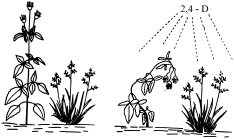
It sounds strange, but it's true, plants are also hormone producers. The word hormones means stimuli and, in plants, these hormones can perform several functions, such as: regulate plant growth, fruit ripening, flower production, rooting, among others. others. Even in small amounts in vegetables, these hormones can trigger important physiological processes. Ethylene gas regulates fruit ripening and leaf fall, for example.
The command for the growth and development of the plant depends, for the most part, on the genes that are present in these plant cells and are influenced by several environmental factors such as light, temperature and availability of water and nutrients. The synthesis of substances, such as different types of hormones, regulates this gene action, which is exercised during the growth and maintenance of vegetative organs and in the emergence and maturation of fruits.
see more
Biology teacher fired after class on XX and XY chromosomes;…
Cannabidiol found in common plant in Brazil brings new perspective…
The best known hormone related to plant growth are the auxins and among them, the most common is indolylacetic acid, known as AIA. The first leaves of a seedling are protected by a structure called the coleoptile, and it is in this structure that AIA production is high in seedlings. We can observe high concentrations of indolylacetic acid also in embryos in the seeds, in the pollen tubes and in the ovary cells of the flower. In an adult plant, AIA production is elevated in the apical buds (sites of meristematic tissues that produce new cells for the plant), mainly in the stems.
The AIA hormone has only one transport route in plants, from the place of production to the place of action, we call this transport polar. Even in very low amounts (millionths of a milligram) AIA can act and stimulate plant growth. In some cases, the dose that is sufficient to stimulate stem growth may inhibit growth. root growth, that is, the same plant has organs that react differently to the same hormone. For the root to reach normal growth, the optimal dose (the one necessary for the phenomenon to occur) is less than necessary for stem growth, we can say that the root is more sensitive to AIA than the stalk.
Auxins act on cell genes by stimulating the production of enzymes that cause a softening of the cell wall, which allows cells to distend. The body shape of plants is usually defined by hormonal action. The apical buds act in the longitudinal growth of the stem, they produce enough auxins to inhibit the lateral buds, causing them to remain in a dormancy stage. If the apical buds are eliminated (in a pruning, for example), the auxin level decreases and the growth starts to be promoted by the lateral buds, the plant starts to have little height and many twigs.
When subjected to intense lateral lighting, coleoptiles grow in the opposite direction to the light rays, this happens because the AIA hormone moves from the illuminated side to the side that did not receive the illumination, acting there and causing the growth of the seedling. On the other hand, if the same coleoptile receives uniform lighting or is subjected to a dark environment, it will grow in a straight line.

If auxins are applied to a stem surface, their presence can promote the growth of adventitious roots, this technique is widely used in vegetative propagation by cuttings. The development of the fruit happens through the sensitive increase of auxin in the walls of the ovary, after fertilization. There is also a type of auxin called 2,4-dichlorophenoxyacetic acid, popularly known as 2,4-D, which is widely used as a herbicide, but 2,4-D only acts on monocotyledonous plants.

A gibberellin it is synthesized in the same places that adult plants produce auxins, that is, in the apical buds. Unlike auxins, the transport of gibberellins is apolar, it occurs from the apex to the base and vice versa, through the phloem. Gibberellins are successfully used in the growth of dwarf plants of some species that have the normal levels of AIA, in this case, for growth to occur, a joint action of these two is necessary hormones. In many species, gibberellin manages to break the dormancy of the seed embryo, causing this embryo to return to activity, avoiding the need for specific stimuli (soaking and light, for example) that would make the seed germinate naturally.
The name of this hormone derives from cytokinesis, as it stimulates cell divisions in the plant. To the cytokinins are produced at the apex of the root and transported by the xylem to the rest of the plant body. The regulatory action of hormones also always works together, while auxin and gibberellin promote cell growth, cytokinins act on cell division. This hormone is also used to prevent aging in leaves, causing them to stay green for longer. Cytokinins can also act to break seed dormancy, flowering and fruit growth. The combination of these three hormones is widely used in spraying in flower shops to maintain flowers and increase the plant's vitality time.
O ethylene It is a gas that acts like a hormone. In an adult plant, it is produced in practically all cells and becomes abundant in the flora after pollination and very abundant in fruits, when in the ripening phase. Thus, when we put a ripe fruit together with other unripe ones, we accelerate their ripening, since the ripe fruit will release ethylene that will reach the unripe fruit. Carbon dioxide can prevent the effects of ethylene, which is why fruit growers use chambers to store fruit and ensure longer shelf life. He is also involved in the fall of leaves, fruits and flowers of the plant.
Denisele Neuza Aline Flores Borges
Biologist and Master in Botany


